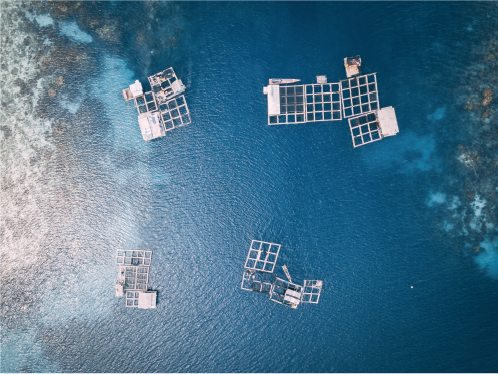Impending food insecurity, the annual rise in global temperatures and the effects of climate change have the world concerned. As scientists scramble to find ways to close the gaps in food security, the deep seas of the planet offer a gleaming ray of hope.
The world population grows at an alarming rate of 1.03%, and the effects of climate change continuously threaten food systems, livelihoods and human nutrition around the globe. As the planet goes through internal turmoil to heal itself, apprehensions surrounding food security continue to grow. Mounting pressures to increase food production have already hit a global high and are expected to grow by almost 60% over the next few decades. As salinity reduces soil fertility, flood waters spoil crops and weather extremes like higher precipitation, harsher winters and hotter summers upset agricultural plans, experts feel they need to turn to something other than land for the cultivation of food for the inhabitants of this earth.
Water, which makes up 71% of the planet, is a largely untapped resource, teeming with food and opportunity for humans and other land creatures. As sea fish, sea insects and even seaweed can become a source of sustenance and nutrition for the hungry mouths on the land, marine aquaculture is fast emerging as a promising solution to food security and climate change.
In layman’s terms, aquaculture is the science of growing plants and animals underwater. Water spans over 71% of our planet and yet produces only 2% of the food source for its inhabitants. The rest 98% of food comes from the remaining 25% of cultivatable land on earth. Merely through its size, one can see the weighty opportunity all this water offers to food farmers – the ocean floor can accommodate the cultivation of much more food than ever possible on land. However, the promising solution is often passed over for its reputation for catalysing environmental degradation. While there may have been a considerable risk of that in the past, technological advances available today can aid people in practising aquaculture responsibly and make it a regenerative, nature-positive food system for the future.
One of the many bright prospects of aquaculture includes three-dimensional farming or stacking one farm over another. A recent study shows that if food cultivators started to prioritise seafood over land-based meat, an expanse of the ocean floor, about twice the size of India, could be spared to grow other things. This increases the amount of food that could potentially be farmed, relieving concerns about food security to a great extent. The production of seafood also leaves a fainter carbon footprint than that of land-based animal protein – about one-tenth of what is left by cows during the farming of beef.
As per studies conducted in China, Chile and the United States, abundant growth of seaweed can provide vital benefits to the surrounding waters, lowering acidity levels and consequent risks of ocean acidification.
A serious advantage of marine aquaculture lies in its strength and resilience to climate change variables. Where crops grown on land and animals reared in pastures are susceptible to harsh weather conditions and the impacts of climate change, the scenario is not entirely as dire for crops grown under water or protein farmed beneath the seas. Exploring food farming opportunities deep-sea will give Mother Earth the time she needs to heal and grow more resilient herself. Shifting pressure off the land and onto the oceans that respond differently to harsh changes in the environment like air temperature, rainfall and soil is expected to add resilience and stability to the mix of food sources for the world. It may also help food producers and general communities maintain stable livelihoods, to an extent.
Marine aquaculture does not just bring the promise of additional cultivatable land or resilience to the table, it is an exceptionally climate-smart system that can help sequester carbon emissions for the world, significantly reducing global warming and its impacts on the environment. Take seaweed, for example. The weeds are touted as superfoods because of the high concentration of vitamins and minerals found in them, as well as the due to high amounts of dietary fibres they contain, that help with weight reduction. The cultivation of these plants can reduce carbon emissions as they grow in deep-sea habitats and not farms, and the plants also have a range of benefits, such as acting as nutrient banks for blue carbon habitats near the shore like mangroves. Seaweed also aids in the farming of shellfish. Intercropping these plants with certain types of molluscs helps to reduce carbon emissions further, making it less taxing on the environment to farm this species of fish. Additionally, when used as a feed supplement provided to cows, or when used in the production of climate-friendly end products such as bioplastics and biochar, seaweed can curb methane emissions even further.
In 2008, the oyster larvae production in two major hatcheries of the Pacific Northwest shellfish industry collapsed. The reason cited for this disaster was something known as ocean acidification which simply means a fall in the pH levels of water caused by high amounts of carbon dioxide in the environment. Ocean acidification, it turned out, has severely negative effects on the production of shellfish by stunting the growth of their shells. What this means, therefore, is that just like the land, the ocean floor is also susceptible to the effects of food production, if done regularly and over long periods of time. Seaweed can greatly aid in the mitigation of the local effects of ocean acidification, through the process of photosynthesis, where it uses up CO2 and converts it into oxygen. As per studies conducted in China, Chile and the United States, abundant growth of seaweed can provide vital benefits to the surrounding waters, lowering acidity levels and consequent risks of ocean acidification.
Environmentalists, aquatic farmers and marine biologists are already working in a cooperative set-up to address the challenges in aquaculture and have positioned key stakeholders at observable positions where they can come and report back on the lessons they learn. As the system is still in its research and development phase, constant learning can help scientists improve their understanding, and their abilities to predict and address environmental concerns and impacts the technology may have on coastal communities.
Bangladesh is a deltaic nation, surrounded by the Bay of Bengal and has a number of rivers running through its relatively small periphery. Capitalising on this resource to the hilt, the country has adopted a ‘blue growth’ economic policy and has fast-tracked to its place of pride as the 5th largest aquaculture producer in the world. The growth trajectory of this sector in the country looks promising. Data from Bangladesh’s Ministry of Fisheries and Livestock and the Bangladesh Bureau of Statistics suggests that fish production in the past 20 years has seen a dramatic increase, from 1.781 million metric tonnes in 2000-2001 to 4.134 million metric tonnes in 2016-2017. As a result, aquaculture has directly or indirectly stabilised livelihoods for almost 18 million people in the country. Studies show that Bangladesh is not simply reliant on catching and selling fish anymore – it is ready to wholeheartedly welcome marine aquaculture to meet its local and overseas demands.
This riverine country has seen resounding success in aquacultural ventures thanks to a number of factors going for it. First, the people of Bangladesh have always been big consumers of fish, so it already had enough local demand for seafood. Moreover, Bangladesh has a rich and diverse reserve of fish, so that gave the aquacultural initiative in the country a decent start from the get-go. According to official data, aquaculture production in this region has increased three times since the millennium year, due to technological boosts as well as producer-friendly regulations. The fish and seafood sector plays a decisive role in the country’s economic development, regularly bringing in foreign export earnings. Experts feel that if Bangladesh is able to boost its product quality and safety standards in fish and shrimp production, the country’s sustained growth in the aquaculture industry will keep its exports competitive and the nation on a positive growth trajectory.
Globally, aquaculture shines as a beacon of hope and opportunity through which humans will be able to sustain life on earth in eco-friendly ways while taking the globe through a new wave of development in the process. Even if the world is ready to reap the benefits of marine aquaculture, farmers, scientists and experts are still years behind the mass initiation of the system. It is only after farms figure out how to further reduce their carbon footprint, consumers come together to support sustainable aquaculture, and all stakeholders such as farmers, governments, global agribusinesses, investors and NGO groups work together, that the world can reap the full benefits of regenerative aquaculture and make it sustainable enough for confidently kickstarting implementation around the world.
















